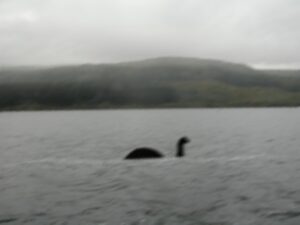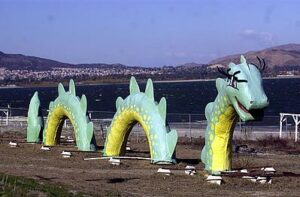Lovely Lake Elsinore, California. A town that has everything! History, fishing, water skiing, annual parades and celebrations, alien abductions, ghosts, satanic cults, and more! While all that other stuff is great, what it is most known for is what we’re going to talk about today…a lake monster!
Lake Elsinore is a town that has a LOT of history. Though it’s currently located in Riverside County, it was inhabited by Native Americans long before settlers arrived. The present day town of Lake Elsinore was legally incorporated in 1888, five years before Riverside County was created. The town was named for the Danish port city of Elsinore, which also happens to be the setting for Shakespeare’s play Hamlet. Lake Elsinore itself has a surface area of over 3000 acres, and is the largest freshwater body in California.
But of course, you guys want to know about the lake monster, affectionately known as Elsie. That’s why we’re here, right? Sometimes the locals refer to it as Hamlet, but that name is the lesser known of the two.
The first known sighting was in 1884, when a creature that appeared to be a cross between a plesiosaur and a sea serpent was sighted in the lake. Now, you’re probably saying to yourself: Jeff, what is a plesiosaur? Well, I’m glad you asked.
First things first, a plesiosaur is NOT a dinosaur. They are from the Triassic period, about 205 million years ago. Plesiosaurs had a broad flat body, a short tail, and sometimes a long neck. Their limbs had evolved into four long flippers, which were powered by strong muscles attached to wide bony plates formed by the shoulder girdle and the pelvis. The flippers made a flying movement through the water. Plesiosaurs breathed air, and bore live young; there are indications that they were warm-blooded. It is believed that Nessie, the Loch Ness Monster, is actually a plesiosaur.
Since this initial sighting, at least once a decade, the creature has been seen.
In 1932, there was another notable sighting, but many believe that one may have been a hoax, since a baby sea lion was recovered at the scene later in the day. But two years later, in 1934, another sighting took place. This time, it was a man named C. B. Greenstreet, along with his wife and children, who reported seeing it. A quote from C.B. says:
“I know you think I’m crazy; but I saw it. We all saw it — my wife and two children, and my little girl was terrified and afraid to return to our home at the head of the lake.”
“It was 100 feet long and had a thirty-foot tail. It would move along near the surface of the water lazy-like, and then all at once it would swish that huge tail and dart like lightning half the length of the lake. Waves as high as light posts washed on the shore in its wake.”
The sightings continued over the years. In 1967, a family boating on the lake supposedly caught a glimpse of it. It supposedly rolled by them, making dark high humps in the water. Then, in 1970, the creature was sighted twice by a Bonnie Play. She described it as being twelve feet long and three feet wide with a series of humps and a dinosaur head…that’s a big size difference from the 100 feet that CB Greenstreet and his family saw! After that, in 1970, three state park officials supposedly saw it surface about fifty feet from their craft, but were too slow to capture any photos of it.
The last known sighting of the creature was in 1992, but no clear details have emerged on what those sightings consisted of. It seems like we may be over due for a sighting one of these days!
Despite the many documented sightings of Elsie, one big factor rules against its existence. The lake itself loses about 4.5 feet of water every year due to dehydration. On top of that, the lake has been completely dry many times over the years. First in the 1930s, and then in 1951, 1955, and the late 1960s. Surprisingly, there weren’t any beached sea serpents lying on the bottom. When it was refilled again in the 1960’s, there has been an ongoing effort to maintain the water level within it.
Those who argue Elsie’s existence claim the creature wandered into a nearby cave in the hills and resided there until the lake was refilled. So, apparently Elsie can survive on both land and water. Clever girl.
Heck, there was even a time with the lake overflowed in the 80s, but still, Elsie did not wash onto any of the surrounding areas. So basically, there is this creature who is maybe living in the lake, or not living in the lake, or maybe it’s hanging out near the lake and sometimes takes a bath.
So what’s the deal? Does Elsie exist, or is it simply the byproduct of over active imaginations?
Let’s actually go BACK…to the plesiosaur theory.
Plesiosaurs lived in salt water, but there is some evidence that they could live in or near fresh water as well. Unfortunately, no one can really confirm this theory, because they creatures died out millions of years ago…OR SO WE THINK! But there is something working against the plesiosaur theory, which is that they are reptiles…and reptiles have lungs, and breathe air. Which means they would have to surface several times a day. Which, in theory, would mean there would be WAY more sightings of it, right? The same goes for the Loch Ness monster.
Well, what about sea serpent? A sea serpent is different from a plesiosaur, because it is a type of sea monster either wholly or partly serpentine. Sea serpents have actually been sighted thousands of times in today’s modern world as well.
Stories of sea serpents go back to Norse mythology, where Jörmungandr was a serpent so long that it encircled the entire world. In 1028 AD, Saint Olaf was said to have killed a sea serpent in Norway, and thrown his body into the mountains.
Stories persisted for years, even during the 1900s, with skeletons being assembled, claiming they were sea serpents.
But, how would one get into Lake Elsinore?
If such a monster DID exist, it’s technically possible that it found its way here millions of years ago, when water covered the area, and then just got trapped when the water receding, making the lake its home for the rest of its life.
It would need a LOT of food to sustain it over its life, however, which, of course, could be provided by the plentiful amount of fish contained in the lake. But could one creature survive for this long on its own? It could be possible that a few of these creatures were trapped, and sustained themselves over time by mating, time and time again. Sure, that’s in-breeding, but you gotta do what you gotta do to survive, right?
There are rumors of a Monster Museum in town as well, dedicated to Elsie and her sightings, but when I visited last summer, there was none to be found. The historical society did have some things on display relating to their famous resident, but all were from their local sports teams.
Now, when folks spot Elsie along the show, it’s the fiberglass version created by residents to tow behind their boat during annual holiday events.
So…WAS Elsie a real creature living in the lake? Could she still be heading out there? Who knows. But residents of Lake Elsinore sure do love a good story. If you’re ever out there way, keep an eye out. You never know WHAT you might see…









![THE FIELD Delivers an Atmospheric Haunting [REVIEW]](https://horrorbuzz.com/wp-content/uploads/2019/10/The-Field-500x383.jpg)


